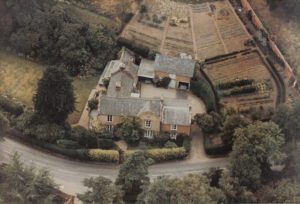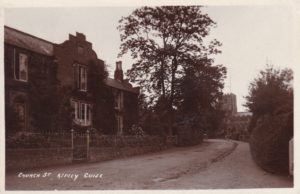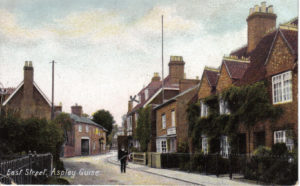The Swan, Aspley Guise
The information here comes from the excellent Community Archives page from the Bedfordshire Archives & Records Service (BARS), with the addition of news stories found through the British Newspapers Archives online.
BARS believes there were two houses bearing the Swan name in Aspley Guise, at different times. Both are now closed. Apart from the Swan being on the county emblem for Buckinghamshire nearby, I have never been able to explain why Aspley Guise had public houses named after a Swan and an Anchor, as it is so far away from any large water source.
The Swan, Church Street
The earliest BARS record of a public house here is that a John Carling was the landlord of a licensed building in Church Street, Aspley Guise, from 1822.
The earliest record I can find in the newspapers (those currently available online) shows the Swan being used as an auction venue for local sales. In a Northampton Mercury of November 1836, a sale was held there of the dwelling house previously used as the Aspley Guise Poor House and three adjoining cottages in the centre of the village. A second lot advertised at the same sale consisted of three further cottages near the Woburn Road. They were all being sold by the Poor Law Commissioners.
The 1841 census (allegedly) shows a public house in Church Street, still with publican John Carling, but the images I have seen of the pages are all too feint to read. The licence was transferred in 1846 to a William Clark, but not without some trouble at the court, as the Bench originally postponed it in April, saying that they were not satisfied the house was being properly conducted. It does not report whom the license was being transferred from, but it successfully changed hands in May, as it was “now well conducted.” Clark lasted less than a year before moving on, being replaced by a J. Sinfield in March 1847, but he did not stay long either.
In 1848, a Thomas Lewis and his wife Sally appeared as witnesses in court after a theft from them. Apparently, they sold oranges and other ‘small articles’ from their public house, which is named as The Swan in Aspley Guise. After they had closed-up and gone to bed one evening, some men came to the door wanting food and drink. Sally opened a window and said she would not let them in. One of the men then said to his companions, “If they won’t let us have some beer, I’ll have some oranges,” and broke the bar window, stealing five oranges that were within reach and went away. Thomas and a lodger went after them, found the men with the oranges and called the constable.
A great deal of research on Lewis appears on the Werelate.org genealogy website. He was baptised in Husborne Crawley in 1806. Married in 1833 to a girl ten years his junior from Bow Brickhill, they went on to have 15 children, five of which did not survive childhood. Lewis was a pig-dealer and moved to Aspley Guise in 1840/41. In 1846 he was charged with assault by the local chimney sweep Frederick Whitlock, after an altercation regarding the ownership of the soot swept from his chimney! The Swan is not mentioned in that report. The case was dismissed.

As in 1846, the Annual Licensing Session reported in the Northampton Mercury, in September 1849, describes the Swan as one of several public houses in the area that had not been well conducted, and the magistrates deferred their decision on whether to renew Lewis’ licence. It is not clear whether his license was renewed at that time, but by April 1850, the family had move to Little Brickhill. Thomas Lewis is later listed as publican of the Kings Arms, Little Brickhill in 1863 (Duttons Directory) and the Shepherd & Flock, Round Green, Luton, by October 1866. The 1891 census finds Lewis living in the Luton Union Workhouse. He survived his wife by less than a year, dying there on 7th June 1891. He was 85 years old.
Back in Aspley Guise, by the time of the 1851 census, Thomas Noble had taken over The Swan. He was described as a Victualler in the census and was 47. He lived with his wife Elizabeth, 42 and daughter Elizabeth, 16. All three were originally from Middlesex. Both this and the last census seem to show that The Swan occupied the building today known as The Shrubbery. This version of the Swan closed sometime in the intervening years between the 1851 and 1861 censuses, as it does not appear as licensed premises in the latter. The likeliest date for this change is July 1853, as both the Bedfordshire Times and Northampton Mercury carried this advertisement:
“ASPLEY GUISE, Bedfordshire. BEAUTIFULLY SITUATED FREEHOLD PROPERTY, consisting of a substantially built DWELLING HOUSE with good cellarage, excellent stable and loft, brewhouse, barn, and piggeries, with Garden and Orchard, containing about one acre, known as the SWAN INN, a Free Public House, and about one mile and a half from the Ridgemount and Woburn Railway Stations. JOHN USHER, Is favoured with Instructions TO SELL the above PROPERTY by AUCTION, at the Magpie Inn, Woburn, on Friday, the 22nd day of JULY, 1853 at 7 o’clock in the evening. Particulars are preparing, and may be obtained from Mr. T. W. Turnley, Solicitor, or of John Usher, Architect and Surveyor, Bedford”.

Perhaps the new owner converted the old Swan into a private house after the sale. Local lady Mabel Chandler, in conversation with the Woburn Sands District Society prior to 1980 publication of “The Story of Aspley Guise”, positively identified it on this site as “the oldest pub in the village”. The book also recounts that as the inn was so close to the Church, it was handy for Vestry meetings and the tradesmen and gentry, assembled at the church according to custom, “…would rapidly adjourn to a warmer site”, i.e the Swan!
The Swan, Bedford Road
About the same time, BARS states a beerhouse was opened in East Street, as Bedford Road was then called, taking the same name. Licensing records list a string of landlords at this “new” Swan for the next sixty years or so, starting with two men in 1853, George Cook, who was also a shopkeeper and Richard Deverell, who was also a farmer.
Samuel Chibnell appears for 1862. There is an Alfred and Jane Chibnall in the 1861 census, in approximately the right place, but no sign of a Samuel. Samuel was also a plasterer, but it appears he went bankrupt in May 1866, when he was described as a builder of Aspley Guise.
In April 1871, the Swan, now run by William Clarke, was the scene of the inquest for a most distressing accident that occurred at the local school. A “lofty gymnastic pole” in the school yard had had ropes attached to the top, on a spinning metal disc, allowing the children to hold the other ends of the ropes and run around the pole, eventually lifting their feet up and swinging freely around the pole, eight or ten at a time. Alas, the pole had rotted through at the base and under the weight of so many playing children, it collapsed like a falling tree. It struck the 14-year-old daughter of Mr G. Bunyan, the local plumber, and killed her instantly. The inquest returned a verdict of Accidental Death, attributing blame to no-one.
The census the same year shows both Innkeeper William and his wife Mary as 23 years old. William was originally from Stoke Goldington, but Mary did not know her birthplace. The name of the beerhouse was not given.
The Bedfordshire Mercury of 30th August, 1879, has a long report of the Aspley Guise and Woburn Sands Horticultural & Cottage Garden Society Show. A Mr Clarke seems to have been a major committee member, which also happened to be the name of the landlord of the Swan at that time. Sadly, it rained all day, even through the performance of the Dunstable Brass Band. The piece reports that at 1.30pm, 40 of the principle patrons and managers sat down at the British School to a “good substantial spread” luncheon, provided by Mr Clarke of the Swan Hotel, Aspley Guise. The house was only really a small beerhouse but perhaps he let some rooms out.

In February 1881, the Leighton Buzzard Observes reported that Mrs Clarke of the Swan had had a daughter. The census later that year shows Innkeeper Clarke with wife Mary, and daughters Sarah, 9, Emily 8, as well as the new 2-month-old baby, Margery. There was also an 11-year-old visitor, Elizabeth Line, in the house. A separate family of William and Harriett Hirdle are also listed as living at the Swan. He was a retired carpenter. Quite a squeeze for such a small building! Perhaps too much of a squeeze, as the Buckingham Advertiser of 27th August 1881 ran an advert that there was a “BEERHOUSE TO LET – the “SWAN,” ASPLEY GUISE; comfortable HOUSE and good GARDEN – Apply MESSRS ALLFREY and LOVELL, Newport Pagnell.”
Clarke found a larger establishment, as he appears at the Black Horse Inn in Woburn by January 1882. (He got himself into some trouble in June 1884 when he grabbed hold of a policeman who had entered the Black Horse to look around!)
The 1881 advert shows the house was by this time in the hands of the Newport Pagnell brewery firm. In fact, it had been theirs since at least 1875, as it appears in a list of Freehold premises included in a sale when the brewery at Newport Pagnell was sold by Rogers & Bull to Allfrey & Lovell. In January 1882, it was still being advertised as to let, with the Bucks Herald promising “…for many years a good business in Letting Carriages has been done.”
BARS records that a Robert Cox was in charge in 1884, when the following “Disgraceful Act” was committed in March, as reported by Croydon’s Weekly Standard, the newspaper for Newport Pagnell. “On Saturday night last, the Wavenden Church Brass Band visited this village, playing as is their occasional custom at Sir Curson Drury Lowe’s, and at the residences of others of the gentry. On preparing to leave the Swan Inn, their last place of call, it was found that the drum had been cut with a knife more than a foot across, consequently upon the first beat a large aperture was made. The band is under the leadership of William Norman, jun., of Bow Brickhill, and it is self-supporting, therefore the loss is keenly felt by them, involving an expense of nearly £2. On the occasion of the Dunstable band fulfilling an engagement at Aspley, the same cowardly and malicious injury was inflicted on them. The Wavendon men have offered a reward of 10s. on the conviction of the offender. There is no Aspley Brass Band, so that jealousy could not have prompted this despicable act.”
In July 1886, beerhouse-keeper Cox dropped his hat while driving his pony and cart and asked a passing young couple to pass it up to him, but they were too afraid of his horse and refused to do so. Enraged, he chased after them and they had to seek refuse in the grounds of a house to escape him. This sorry tale was taken to court, but the magistrates dismissed the case.
Cox moved on in July 1889 and was replaced by Josiah William Brown. He stayed a couple of years and was then replaced by William John Kempster. He appears in the 1891 census just as a Livery Stable Keeper, but under West Street? He lived with his wife, two daughters and one son. I think this is the entry for the Swan as there is no other suitable. I presume it was he who was trying to find a new tenant in 1894. Northampton Mercury, 23rd March: “TO LET, the SWAN INN BEERHOUSE, ASPLEY GUISE, with Garden, Stable, and Fly Business. – Apply to Tenant.” Perhaps he was already unwell, as shortly after leaving, he passed away in December that year. The Luton Times: “DEATH OF MR. KEMPSTER. – A much respected inhabitant passed away on Saturday morning last in the person of Mr. J. W. Kempster, who until recently was landlord of the ‘Swan’ Inn. For some three months he had been suffering from an internal complaint. Dr. Veasey being his medical attendant. He had been in the parish some seven or eight years, was a quiet man, honest and straightforward. The funeral took place on Wednesday afternoon.”
Thomas Barrett took over the Swan, and his daughter Lily was mentioned as a witness in the trial of Thomas Grace in May 1896, who had stolen a shilling and used it to buy beer at the Swan. The Barrett’s had gone soon after, as the licence was transferred from Joseph Francis Smith to John Atterbury in July 1897. Atterbury was in court in 1899, after a drunk had caused so much trouble outside the Swan that the Police had been called. The court found that George Labrum had also insulted the landlord’s wife. He was eventually fined 5s. and 8s. 6d. costs. Also, at this time the brewers Allfrey and Lovell converted their partnership into a company and became the Newport Pagnell Brewery Company.
The 1901 census shows that Atterbury, 52, was from Woburn; and his wife Sarah, 44, from Husborne Crawley, with sons Charles, 18, William, 16 and daughter Elizabeth, 5, all born in Aspley. Atterbury was described as a publican of the Swan Inn.
Atterbury transferred his licence to William Doughty in May 1906. Doughty had previously run the White Horse Inn, at Linslade, yet before the end of the year, the licence had been temporarily transferred again, this time to John Hattil Hines, of Beeston, Nottinghamshire, and he would see the beerhouse through to the close. Unusually, the 14th December 1906 Luton Times report of the transfer mentions that the rental of the beerhouse was £5 a year. It was fully transferred in January 1907.
Some interesting statistics for local licensed house appeared in the Luton Times in February. For the Woburn Petty Sessions area (of which Aspley Guise formed a part) there were 49 fully licensed establishments, and 18 beerhouses, as well as one off-license and three wine licences. The Swan was one of only four which had changed hands twice within a year. 33 people had been brought to court for matters involving drink. Overall, the court considered the businesses were being conducted in a satisfactory manner and there was no suggestion coming from any parish that any licensed house was ill-conducted or superfluous. Yet just two years later, at the Annual Licensing session, it was noted that the Swan at Aspley Guise license would be “held back for a month.”
The Woburn Bench submitted the Swan to be referred and closed to the County Licensing Committee. When they met at County Hall, Bedford at the end of May, all 19 licensed premises so submitted were closed, with the Compensation Authority due to meet a month later. At that meeting, it was decided to award the Newport Pagnell Brewery Company £126 and Hines £20.
The Swan beerhouse finally closed in December 1909. In 1910 the Domesday Survey was carried out throughout the country to obtain an accurate picture of all landholding ownership. This survey shows John Hattil Hines still at 3 Bedford Road, but the house was still owned by Allfrey & Lovell, the Newport Pagnell brewers. John Hines continued to run his cab business from the house, and was there for the 1911 census, described as a Jobmaster, aged 38, with wife Elizabeth, 38, sons Percy, 13, Gary, 10 and daughter Mabel,7 as well as a boarder, Albert Denton.
Today, the house is known as The Old Swan.
List of Licensees
The Swan, Church Street
1822-1841 John Carling
1846-1847 William Clark
1847 J. Sinfield
1848-1850 Thomas Lewis
1851 Thomas Noble
The Swan, Bedford Road
1853 George Cook (also shopkeeper) and Richard Deverell (also farmer)
1854 George Cook
1862 Samuel Chibnell (plasterer)
1871-1881 William Clarke
1881-1882 Henry Sutton
1882-1884 Robert Morton
1884-1889 Robert William Cox
1889-1891 Josiah William Brown
1891-1894 William John Kempster
1894-1896 Thomas Barrett
1897 Joseph Francis Smith
1897-1906 John Atterbury
1906-1907 William Doughty
1907-1909 John Hattil Hines
1909 Closed
Webpage last update September 2019.
